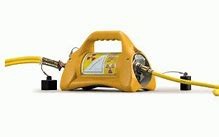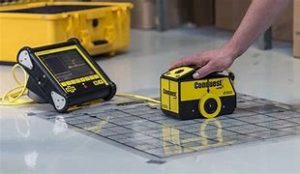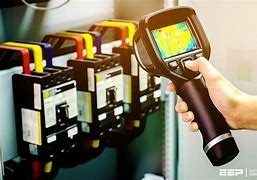Updated: April 2025
Overview
During construction and renovation projects an inspection of concrete, pipes, rebars, post-tension cables, etc., may be necessary. Also, this type of work may be necessary to identify hidden reinforcing steel bars, plumbing, or conduit within the concrete. The methods are; Industrial Radiography (IR), Ground Penetrating Radar (GPR), and Ultrasound (US). Other types of scanning include Infrared scanning of electrical cables.
Industrial Radiography (IR) – EHS Permit Required
Industrial radiography is performed by using ionizing radiation (gamma-ray generated by a high-intensity gamma radiation source or X-ray generated by a radioactive source or by an x-ray machine).
Fig. 1 – Examples of Industrial Radiography devices
The radiation sent by the IR device penetrates the material and is absorbed in different degrees depending on the density of the material. An image is obtained and analyzed to determine the existence of holes, cracks, defects, etc. The main advantage of this method is a clear picture of the structure being inspected. The main disadvantage is the need to evacuate persons in a relatively large area to prevent radiation exposure. Due to this disadvantage, if the area cannot be evacuated (e.g.: hospitals), a Ground Penetrating Radar (GPR) or other methods are preferred.
When a clear image of the inspected structure is required and the surrounding area can be evacuated, the Industrial Radiography method may be utilized.
Only Industrial Radiography (IR) projects require an Industrial Radiography Permit from EHS Radiation Protection Service. More information on the IR permit approval process can be found here: Industrial Radiography Permit Application Process.
Ground Penetrating Radar (GPR) – No EHS Permit Required
The GPR system uses non-ionizing radiation (Radio Frequency) to perform similar inspections on concrete structures.
Fig. 2 – Examples of Ground Penetrating Radar devices
The radio frequency used by the GPR is reflected differently by the different parts of the structure being investigated. The reflected radiation is measured with a scanning device. This reflected radio frequency is not hazardous to the human body, therefore the GPR method can be used without restrictions.
Ultrasound (US) – No EHS Permit Required
More recently a new technique based on ultrasound is being used
Fig. 3 – Examples of Ultrasound devices used for concrete scanning
The Ultrasound and Ground Penetrating Radar methods have similar advantages and disadvantages.
Infrared Scanning of Electrical Equipment – No EHS Permit Required
Infrared scanning of electrical components and systems is part of the maintenance program of the electrical equipment. During this scanning process, the equipment used measures the infrared radiation (heat) emitted by the electrical components. Since no radiation is emitted for the scanning process, the procedure does not pose a radiation hazard.
Fig 4 – Infrared Scanning of the electrical equipment
Since the Infrared Scanning of electrical equipment, the Ground Penetrating Radar and Ultrasound methods do not pose a hazard to the persons, no EHS permit is required to perform these scanning processes.







